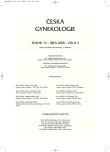Caesarean Section – Indication or Choice?
Authors:
P. Křepelka
Authors‘ workplace:
Katedra gynekologie a porodnictví IPVZ, Praha, ředitel doc. MUDr. J. Feyereisl, CSc.
; Ústav pro péči o matku a dítě, Praha
Published in:
Ceska Gynekol 2008; 73(5): 303-307
Category:
Original Article
Overview
Currently, caesarean section is the most commonly indicated procedure. The proportion of caesarean deliveries continues to rise. And the spectrum of surgical indications has dramatically broadened.
This contemplation is focused on the general outcome of surgical indications.
The procedure is indicated on the basis of scientific evidence only in a limited manner, more often it is indicated on the basis of empiric results and significant subjective motivation of the participants - the indicating physician and pregnant patient.
There is insufficient proof to conclusively demonstrate an increased or decreased risk of elective caesarean section as compared to a trial of labor. Thus making it ethical and professionally acceptable to perform a caesarean section based on the wish of a competent and well-informed pregnant woman.
Key words:
autonomy, informed consensus, caesarean section, surgical indications.
Sources
1. Florica, M., Stephansson, O., Nordstorm, L. Indications associated with increased Cesarean section rates in Swedish hospital. Int J Gynaecol Obstet, 2006, 92, p. 181-185.
2. Grobman, WA., Lai, Y., Landon, MB., et al. Prediction of uterine rupture associated with attempted vaginal birth after cesarean delivery. Am J Obstet Gynecol, 2008, 199, p. 30.e1-30.e5.
3. Hannah, ME., Hannah, WJ., Hewson, SA., et al. Plannes Caesarean section versus planned vaginal birth for breech presentation at term: a randomised multicentre trial, Lancet, 2000, 356, p. 1375-1383.
4. Hansen, AK., Wisborg, K., Uldbjerk, K., et al. Elective Caesarean section and respiratory morbidity in the term and near-term neonate. Acta Obstet Gynecol Scand, 2007, 86, p. 389-394.
5. Hofmeyr, GJ., Hannah, ME. Planned caesarean section for term breech delivery. Cochrane Database of Systematic Reviews 2003, Issue 2. Art. No.: CD000166. DOI: 10.1002/14651858.CD000166.
6. Hook, B., Kiwi, R., Amini, SB., et al. Neonatal morbidity after elective repeat cesarean section and trial of labor, Pediatrics, 1997, 100, p. 348-353.
7. Horey, D., Weaver, J., Russell, H. Information for pregnant women about Caesarean birth. Cochrane Database of Systematic Reviews 2004, Issue 1. Art. No.: CD003858. DOI: 10.1002/14651858.CD003858.pub2.
8. Kalish, RB., McCullough, B., Chervenak, FA. Patient choice Cesarean delivery: ethical issues. Curr Opin Obstet Gynecol, 2008, 20, p. 116-119.
9. Lavender, T., Hofmeyr, GJ., Neilson, JP., et al. Caesarean section for non-medical reasons at term. Cochrane Database of Systematic Reviews 2006, Issue 3. Art. No.: CD004660. DOI: 10.1002/14651858.CD004660.pub2.
10. Martin, JA., Hamlton, BE., Sutton, PD., et al. Births: Final Data for 2005. National Vital Statistic Reports, 2007, 56, p. 2-104.
11. Payne, J. Lze určit kompetenci nemocného? Čas Lék čes, 2004, 143, s. 405-407.
12. Rodička a novorozenec 2006, ÚZIS 2007, ISSN 1213-2683.
13. Young, JH. Caesarean section, the history and development of the operation from earliest times. HK Lewis, London 1944, p. 1-233.
Labels
Paediatric gynaecology Gynaecology and obstetrics Reproduction medicineArticle was published in
Czech Gynaecology

2008 Issue 5
Most read in this issue
- Long-term Low Molecular Weight Heparin Protection during Pregnancy for the Recurrent Fetal Loss
- Myoms, Fertility and Pregnancy
- Caesarean Section – Indication or Choice?
- Vaginal and Postpregnancy Inflamations, Risks of their Treatment for Fetus
